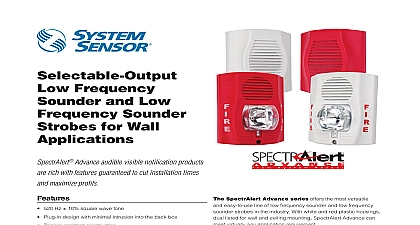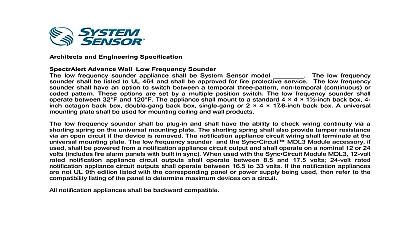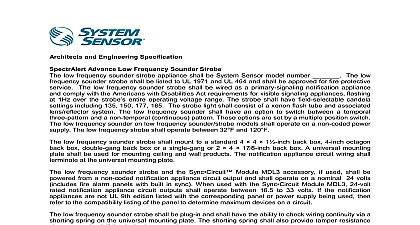System Sensor Low Frequency Sounders and Sounder Strobes

File Preview
Click below to download for free
Click below to download for free
File Data
| Name | system-sensor-low-frequency-sounders-and-sounder-strobes-9054136728.pdf |
|---|---|
| Type | |
| Size | 696.69 KB |
| Downloads |
Text Preview
Frequently Asked Questions Frequency Notification Appliances Sounder Strobes and Sounder Bases is included with the new L Series Low Frequency offering latest line of Low Frequency provides lower current draw plus provides versatility for non ADA The offering includes Wall and ceiling options New round and compact models Full Candela range Lower candela settings are great for non ADA rooms T3 T4 continuous and coded tones Now with high and low volume settings Red and white models UL FM and CSFM approved there compact options for replacing Mini Horns System Sensor now has 2x4 compact sounder models that are great for retrofits compact models have the full feature set but in a smaller more attractive footprint the L Series Low Frequency parts be compatible with the SWIFT AV base the standard size models fit the SWIFT AV base The latest SWIFT firmware and SWIFT tools will recognize the L Series Low Frequency products so that battery life can be accurately predicted legacy low frequency sounder bases still be available we will continue to offer the low frequency sounder base that works in combination with system detector you meet the low frequency requirements with voice evacuation systems L Series speakers are another option to meeting the code Per UL to show conformance the low frequency requirements as required per Section 18.4.5.3 the low frequency sound with the system the fire alarm panel amplifier and speaker s needs to be tested and listed low frequency application the System Sensor low frequency devices synchronize with legacy frequency products plus the normal horns and horn strobes new line of low frequency sounder sounder strobes and sounder bases are fully compatible our system sensor synchronization protocol long will the SpectrAlert Advance Low Frequency models still be available will be available until December 1 2019 availability after that date is only while supplies last Frequency History is the low frequency sounder requirement 2010 edition of NFPA 72 added a new requirement in Section 18.4.5 Sleeping Area Requirements says where audible appliances are provided to produce signals for sleeping areas they shall a low frequency alarm signal that complies with the following The alarm signal shall be a square wave or provide equivalent awakening ability The wave shall have a fundamental frequency of 520 Hz 10 percent addition the 2012 edition of NFPA 720 has incorporated low frequency 520Hz into Section 6.4.4.3 Sleeping Area Requirements 9 19 was the initial compliance date for low frequency installations for NFPA 72 1 2014 The NFPA 72 2010 technical committee allowed and national recognized test labs such as UL FM Intertek time to develop products and test standards to comply this new requirement was the compliance date for low frequency installation for NFPA 720 1 2015 was this new requirement added to the standard 2006 the Fire Protection Research Foundation FPRF funded research studies to focus on the effectiveness of the 3Khz tone two high risk groups Waking Effectiveness of alarms for adults who are hard of hearing NFPA Dorothy Bruck Ian Thomas June 2007 Waking Effectiveness of alarms for the alcohol impaired NFPA Dorothy Bruck Ian Thomas June 2007 aim of the studies was to optimize the performance to meet the needs of these high risk groups The study six signals and found that a square wave low frequency with a fundamental frequency of 520 Hz is the most effective for awakening people especially those with mild to severe loss this requirement the same in the 2013 edition NFPA 72 Chapter 18 Committee revised the wording to clearly state the frequency requirement is to awaken people only this requirement also apply to Section 29.3.8.1 Household fire alarms only where required by governing laws codes or standards people with hearing loss or where provided voluntarily for those hearing loss Section 29.3.8.1 requires low frequency sounders addition a similar requirements is impacting Section 29.3.8.1 for carbon monoxide detection systems the International Building Code or International Fire include this new low frequency requirement 2012 IBC and 2012 IFC both reference NFPA 72 2010 and 720 in their reference standards section Chapter 35 and 80 does the standard apply requirement applies to new sleeping spaces Some specific include Hotels Motels Retirement Assisted living facilities with no trained staff on hand College University dormitories Apartments Condominiums 2012 IBC and 2012 IFC both require low frequency sounders R1 Hotels and Motels and R2 College and University by referencing NFPA 72 low frequency sounders also required in the of the sleeping areas intent of the code is for the low frequency sounders to only be in designated sleeping areas to awaken people there a requirement that the tones be the same the sleeping room and the hallway only requirement is that the tones synchronize within the zone the low frequency sounders required for only rooms in hotels you need to comply with the requirements of Section 18.4.5 of 72 or Section 6.4.4.3 of NFPA 720 then the intent of the is to require them in every sleeping room If you are required comply with the requirements of Section 29.3.8.1 of NFPA 72 or 29.3.8.1 of NFPA 720 then the low frequency sounders may required for someone with mild to severe hearing loss does this apply to retrofit applications requirements in NFPA 72 and chapter 907.2 of the IFC do not retroactively to existing systems There are situations when AHJ may require an existing system needs to be brought up current criteria even though the system still meets the minimum of the version of the code that was in effect at the time the original installation Several examples are Changes made to an existing system such as replacing a portion or all components of a system An AHJ may determine that an existing system may present a hazard to life or property essential to consult with the local AHJ before bidding on an project I have to use a different dB meter to test these low devices dB requirements and method to measure the dB output is the as with other traditional notification appliances such as a horn horn strobe follow manufacturer instructions and your local building code for the use and installation of any audible visible notification System Sensor AVFL13707 9 19


